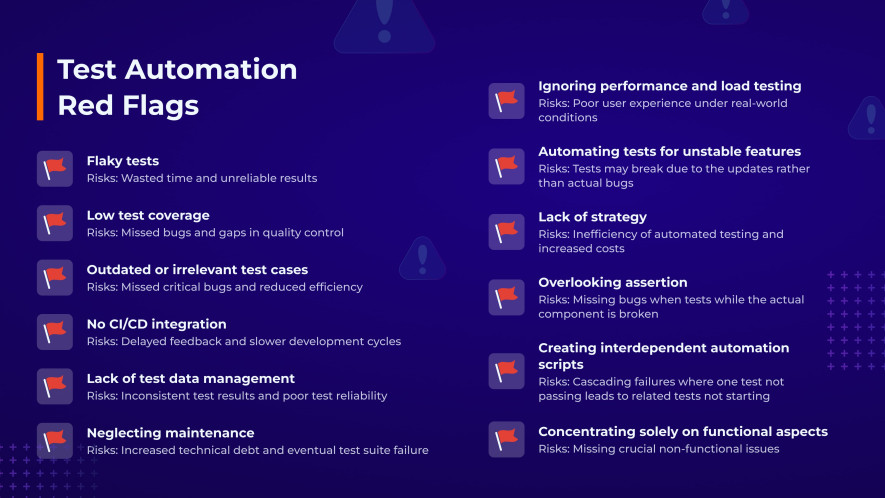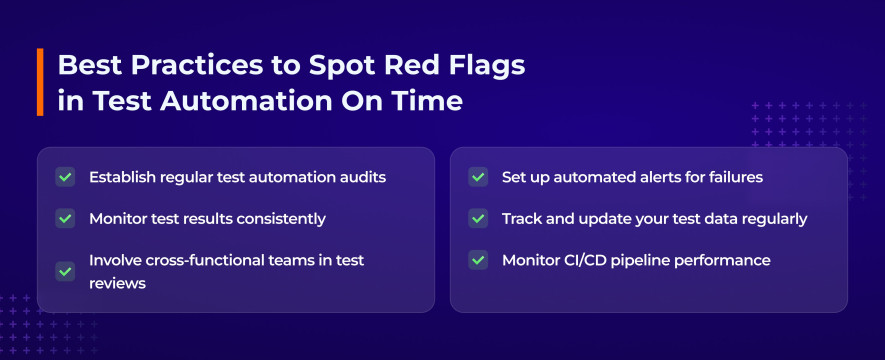- QATestLab Blog >
- Automated Testing >
- Warning Signs: How to Identify Inefficient Test Automation in Your Project
Warning Signs: How to Identify Inefficient Test Automation in Your Project

As a QA provider with two decades of experience in software testing, we have witnessed firsthand the challenges that arise when test automation is not set up or maintained efficiently. Time and again, our team has been brought in to address issues that could have been prevented with proper planning and execution. While we are always ready to fix what is broken, the reality is that it is much easier — and more cost-effective — to avoid these problems in the first place.
Test automation is meant to be a powerful tool that drives faster releases, improves product quality, and reduces the strain on manual QA engineers. However, when not set up and supported properly, it can easily become a source of frustration, wasting both time and resources. We have seen numerous projects where inefficiencies in test automation processes led to delays, missed deadlines, and spiraling costs — issues that could have been prevented with better foresight.
In this article, we will be sharing some of the key warning signs that indicate your test automation might be going in the wrong direction and the risks that come with it. Efficient test automation is not just about the initial setup, which undoubtedly requires a significant investment of time and collaboration from your entire tech team. That is only the beginning. Maintaining the stability and relevance of your automation processes is vital to ensure your initial investment pays off and continues to deliver the benefits you expect.
Whether you are a QA manager, Tech Lead or a Project Manager this article will help you identify potential red flags in your test automation before they become costly problems. By recognizing these signs early, you will have the opportunity to take action before those issues become too complex and expensive to resolve.
Key Factors That Determine the Quality of Your Test Automation
To begin this article, let’s list some of the most crucial factors that significantly influence the quality of automated testing. Proper planning and execution of these elements are essential to ensure that your test automation efforts deliver the intended results.
Test Coverage
Test coverage refers to how much of your software’s functionality is covered by your automated tests. If your automation strategy only covers a small portion of your product, it leaves many potential bugs undetected. Prioritizing high-risk areas and critical features for automation ensures your efforts are focused on the most impactful parts of your software.
CI/CD Integration
Continuous Integration and Continuous Delivery are essential for embedding automated tests into the software development lifecycle, enabling immediate feedback with every code change. This integration allows for automated test execution during each build, ensuring rapid detection of defects. Incorporating test automation into a pipeline can trigger test suites upon every commit, deployment, or pull request, allowing teams to react fast and address issues before they propagate. Automating this process also reduces manual intervention and fosters a more efficient agile environment.
Scalability
Scalability is key to handling the growing complexity and functionality of modern applications. As test suites grow, your automation framework should be able to execute thousands of tests efficiently, without significant degradation in speed or resource consumption. To achieve scalability, engineers can leverage parallel test execution, optimize test data management, and implement containerized environments. A scalable framework ensures that as your project expands, the automation suite remains reliable, fast, and cost-effective.
Maintainability
Automated tests require regular updates and maintenance, especially as your software evolves. A well-maintained test suite should be easy to modify and adapt to changes without causing large-scale rework. A maintainable test suite should utilize design patterns like Page Object Models (POM) for UI tests and service abstraction layers for API tests. Modular, reusable code reduces redundancy and allows for easy updates to tests when the application changes.
Test Data Management
Test data management is crucial for ensuring consistent and repeatable test outcomes. Automation frameworks should handle data provisioning dynamically, generating or retrieving appropriate test data based on the scenario being tested. Strategies like data-driven testing (DDT) can decouple test logic from test data, making it easier to test various input combinations without rewriting scripts. Employing databases or cloud-based services for storing and managing test data ensures stability and allows for the replication of real-world scenarios, ultimately increasing the reliability of test results.
Tool Selection
The tools you choose for your test automation process can significantly impact its quality. It’s important to select tools that fit your project’s requirements, integrate smoothly with your development environment, and provide robust reporting. Using the right tools helps ensure efficient testing, clear results, and a streamlined workflow.
By focusing on these key factors, you can create a robust and effective test automation process that provides reliable results and supports your team in delivering high-quality software. Now, let’s move on to discussing the most important and common warning signs that indicate your automated testing approach needs recalibrating.
Test Automation Red Flags to Watch For
After analyzing dozens of cases that our team of QA Automation engineers have worked on, we have identified a list of the most dangerous red flags that tech teams often miss in their test automation processes. While some of these warning signs are obvious, others are subtle and easily overlooked, which means teams do not spot them until it is too late. This leads to costly consequences in terms of both time and resources.
Here are the most critical test automation red flags and the risks they pose:

Red Flag #1: Flaky Tests
Flaky tests are those that pass and fail inconsistently without any changes to the underlying code. Flaky tests often result from unstable test environments, asynchronous code execution, or improper wait conditions. These tests add significant noise, polluting CI/CD pipelines with false positives. Over time, a lack of consistent results undermines confidence in automated testing, as developers spend unnecessary cycles troubleshooting non-reproducible issues.
Red Flag #2: Low Test Coverage
Low test coverage means that only a small portion of the application is being tested through automation, leaving large parts of the software unchecked. This often results in undetected bugs slipping through the cracks and impacting production. Teams relying on manual testing to fill the gaps in coverage may experience slower releases and higher development costs.
Red Flag #3: Outdated or Irrelevant Test Cases
As software evolves, your test cases should evolve with it. If your test cases are not regularly updated to reflect new features, deprecations, or changes in code, they will quickly become obsolete. Outdated test cases may fail to catch new bugs or may focus on areas of the application that are no longer relevant, resulting in wasted resources and reduced test coverage.
Red Flag #4: No CI/CD Integration
As we have already mentioned in the previous chapter, CI/CD integration is one of the pillars of efficient automated testing. One of the core benefits of test automation is the ability to receive quick feedback on code changes. If your automated tests are not integrated with a CI/CD pipeline, you are losing valuable time. Without automated testing in CI/CD, teams are forced to manually trigger tests or rely on scheduled test runs, delaying feedback and slowing down the entire development cycle.
Red Flag #5: Lack of Test Data Management
Inadequate management of test data can lead to inconsistent test results and unreliable outcomes. If your tests rely on hardcoded or unstable data, they are likely to fail even when there are no defects in the code. Proper test data management ensures that your tests are run with realistic and reliable data, making them more accurate and reflective of real-world use cases.
Red Flag #6: Neglecting Maintenance
Test automation is not a “set it and forget it” process. Tests must be maintained, reviewed, and updated regularly. When maintenance is neglected, the test suite can accumulate technical debt, making it harder to manage, prone to failures, and ultimately ineffective. Regular test audits, refactoring, and updates are essential to maintaining a healthy and efficient test automation process.
Red Flag #7: Ignoring Performance and Load Testing
While functional testing ensures that individual features work as expected, performance and load testing are essential for understanding how your application behaves under stress. If those types of tests are ignored or sidelined, you may miss critical issues that could affect the user experience when the application is deployed at scale. This can result in slow load times, crashes, or unresponsiveness under heavy use.
Red Flag #8: Automating Tests for Unstable Features
Automating tests for features that are still being updated on a regular basis introduces several risks. Tests are likely to break due to changes in the feature rather than actual bugs, leading to unreliable test results and frequent false failures. This creates an ongoing maintenance burden, as test scripts must be constantly updated to reflect the latest changes, which can significantly delay feedback loops and slow down the development process. Over time, this can erode confidence in the test automation suite, making it more of a liability than a benefit.
Red Flag #9: Lack of Strategy
The lack of a clear strategy in test automation leads to inefficiencies and misalignment of resources. Without a well-defined plan, teams may focus on automating low-priority tests while missing critical areas. This can drive up maintenance costs, as poorly planned automation often requires frequent updates and fixes. Ultimately, the absence of a strategy results in wasted time, increased costs, and an automation suite that fails to deliver its intended value in improving product quality and speeding up releases.
Red Flag #10: Overlooking Assertion
In automated tests, assertions are conditions used to verify if the test results match the expected outcomes. Overlooking assertion can lead to incomplete test coverage, as the test may run without actually validating whether the application behaves as intended. This can result in false positives, where tests pass even though bugs in the component are present, giving teams a false sense of security. In the long term, neglecting assertion compromises the effectiveness of the test suite, as it fails to catch issues that could impact product quality and user experience.
Red Flag #11: Creating Interdependent Automation Scripts
Creating interdependent automation scripts can lead to cascading failures, where the failure of one test causes related tests to not start or fail incorrectly. This dependency increases the fragility of your test suite, as a single test failure can halt the execution of multiple other tests, making it difficult to pinpoint the root cause of the problem. As a result, valuable time is wasted on investigating false failures, which delays feedback and reduces the overall efficiency of the test automation process. In the long run, such cascading failures in scripts can significantly hinder productivity and confidence in the automation suite.
Red Flag #12: Concentrating Solely on Functional Aspects
Focusing too much on functional aspects of test automation while neglecting non-functional areas can lead to critical issues being overlooked, such as performance, security, or usability problems. Ignoring these non-functional aspects can result in poor user experience, slower response times, or vulnerabilities that impact the product’s reliability and market success. Ultimately, this oversight causes customer dissatisfaction and higher costs to fix these issues post-release.
How to Spot Red Flags in Your Test Automation Early
One of the main responsibilities of a QA Tech Lead or Project Manager is ensuring that the test automation process remains efficient and aligned with the project’s objectives. Detecting red flags early can help avoid costly fixes later on and ensure consistently high software quality, making product maintenance less resource-intensive.
Here are a few practical steps you can take to notice the red flags we discussed in this article on time:

1. Establish Regular Test Automation Audits
Regular audits of your test automation framework are crucial to identifying inefficiencies before they escalate. Schedule routine reviews of your automated tests to evaluate their stability, relevance, and coverage. During these audits, check for outdated or redundant test cases, low test coverage in critical areas, and test failures that indicate underlying stability issues. An audit will also help assess whether your tests are still aligned with the latest software updates and business requirements.

2. Monitor Test Results Consistently
Use continuous monitoring and reporting to keep a close eye on the performance of your automated tests. This involves tracking key metrics such as pass/fail rates, test execution time, and the number of flaky tests over time. Regularly analyzing these metrics helps you spot patterns that could indicate problems — such as an increase in flaky tests or longer test execution times — which may require immediate attention and action. A dashboard integrated with your CI/CD pipeline can provide real-time updates on test health, allowing you to act quickly when issues arise.
3. Involve Cross-functional Teams in Test Reviews
Collaborating with developers, product managers, and other stakeholders during test reviews can provide fresh perspectives on the current state of the automation process. Involving the development team in the test case review process ensures that tests are aligned with the latest features and code changes. Cross-functional collaboration can also help identify gaps in test coverage and verify whether existing tests still meet business objectives and technical requirements.
4. Set Up Automated Alerts for Failures
Automated alerts are a simple yet effective way to identify potential issues in your automation process before they turn into bigger problems. Setting up notifications for test failures in your CI/CD pipeline ensures that any red flags, such as unexpected test failures, are flagged immediately. This allows your team to investigate and resolve issues quickly, minimizing their impact on the development cycle and ensuring that bugs are caught early in the process.
5. Track and Update Your Test Data Regularly
To avoid outdated or insufficient test data and inconsistent test results, implement processes for regularly reviewing and updating it. This will help your team ensure the data is representative of production environments and new features.
6. Monitor CI/CD Pipeline Performance
Regularly assess the performance of your CI/CD pipeline to see whether your automated tests are running smoothly. If the pipeline is overloaded or slow, it can delay feedback loops and hide potential issues within your automation suite. Monitoring pipeline health allows you to identify inefficiencies and optimize the pipeline to ensure fast and reliable execution of automated tests.
By following these steps, tech teams can foster a proactive approach to identifying and addressing test automation red flags early. Regular monitoring, auditing, and collaboration across teams are key to maintaining the effectiveness of your test automation framework and ensuring that potential risks are caught before they turn into bigger problems.
Main Takeaways
As we have discussed throughout this article, maintaining an efficient and high-performing test automation process requires more than just a solid setup. It’s an ongoing commitment that involves continuous monitoring, auditing, and collaboration.
Recognizing the red flags early is equally important. Flaky tests, low test coverage, outdated test cases, a lack of a well-thought-out test strategy, and other warning signs we have explored in this article can seriously undermine the effectiveness of your automation suite, leading to increased development costs and missed deadlines. Regular audits, test result monitoring, and the involvement of cross-functional teams are essential to staying ahead of these issues.
If you notice any of these red flags or feel that your test automation could be more efficient, don’t hesitate to reach out to our team. We specialize in helping companies improve their automation processes, whether it is by reviewing and updating existing tests or expanding automation coverage. Our experts are here to ensure your test automation delivers the results you expect. Contact us today to work together on safeguarding the quality and efficiency of your software.
Learn more from QATestLab
Related Posts:
- Automation Testing for Mobile Apps: Why It’s Essential and Our Key Services
- QA Automation Tools: Low-Code, No-Code, or Coding-Based?
- Test Automation Myths: Where the Truth Ends and the Myth Begins?
About Article Author
view more articles






